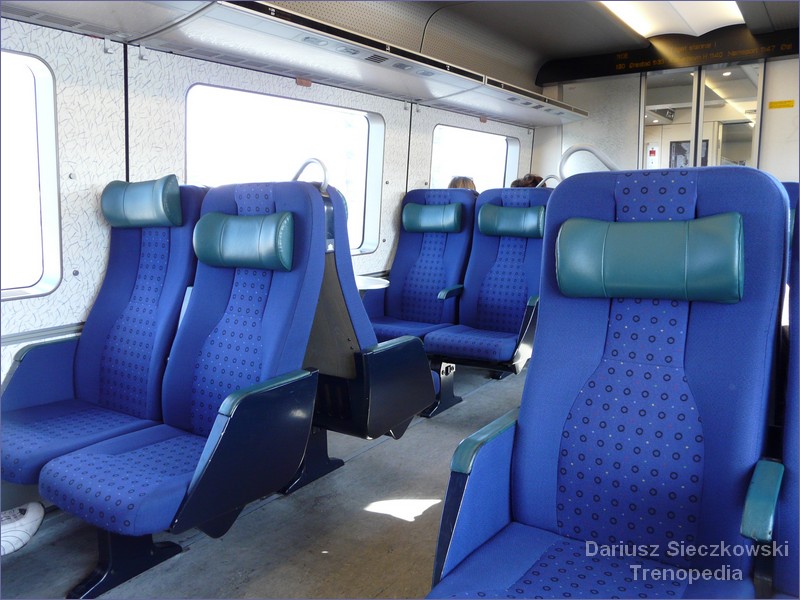Traveling by train in Sweden is a comfortable way to explore the country. Trains run between the largest cities, and there are also night trains to sparsely populated regions, from where passengers can continue their journey by bus from the railway stations in charming small towns. Train travel in Sweden is relatively expensive, but there are many discounts and special offers or you can travel with an Interrail. Passenger traffic has increased significantly in recent years.
Last updated: 20.07.2025
The first railway in Sweden was completed in 1855. The Frydstakbanan from Frykstad to Klara Älvs, in the province of Värmland was built to 1188 gauge and initially carriages were drawn by horses. Soon after the opening horses were replaced by steam locomotives.
On 5 March 1856 the railway line Nora – Örebro was opened. The line was built on standard gauge.
In 1862 the railway line Stockholm – Göteborg was inaugurated. Trains covered the distance of 455 kilometers in 14 hours.
In 1902 the railway line between Luleå and Narvik was completed.
In 1909 the train ferry line between Trelleborg and Sassnitz was inaugurated.
In 1919 a bridge was built over the river Torne to connect Haparanda with the Finnish town of Tornio.
Table of contents:
1. Domestic trains
2. Types of the trains (SJ)
3. Night trains
4. The best offers for visitors
5. Narrow-gauge railways in Sweden
6. Heritage railways in Sweden
7. Inlandsbanan
8. Railways on Swedish islands
9. Funicular railways in Sweden
10. Swedish Railway Museum
11. International trains
1. Train travel in Sweden – domestic trains
Rail transport in Sweden is very well organized. There are many daytime and overnight trains – from suburban trains to high-speed X2000 and X3000 trains. Passenger trains are mostly operated by state-owned SJ, but there are regional passenger operators in individual provinces. Ticket prices varies depending on the train, tickets cannot be purchased on board.
Very popular among tourists is the Inlandsbanan a 1,200-kilometre long route through sparsely populated rural area.
Long-distance routes are commercial, regional passenger services aresubsidised by the regional public transport authorities.
Useful websites:
sj.se – SJ AB official website, search engine, e-shop
Snälltåget – night trains operator
VY – long distance passenger operator
Arlanda Express – passenger service between Stockholm and Arlanda Airport
MTRX – express trains between Stockholm and Gothenburg
Flixtrain – express trains between Stockholm and Gothenburg
Storstockholms lokaltrafik – local transportation in Stockholm area
Railway map of Sweden (Wikipedia)
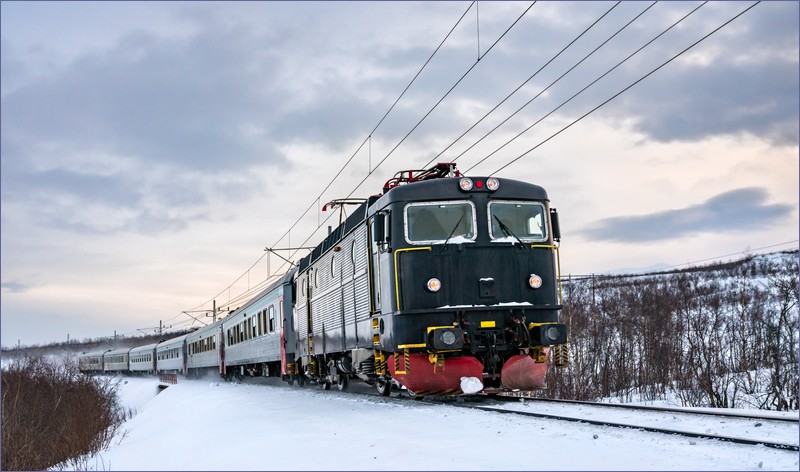
2. Types of the trains (SJ)
Swedish Railways has several categories of trains. Regardless of category, trains are clean, fast and comfortable, although sometimes trains are significantly delayed.
X2000 – electric high-speed tilting train constructed by Kalmar Verkstad in Kalmar. The first X2000 train was put into operation in 1990 as a first-class only train. Second class was introduced in 1995. The top speed allowed in regular traffic is 200 km/h. Trains run from Sundsvall in the north to Copenhagen in the south. In 2020 X2000 trains were refurbished.
Facilities onboard: Wi-Fi, bistro, free refreshments in 1st Class, animal-permitted zone, quiet zone and wheelchair lifts.
X3000 – newest SJ’s train manufactured by Bombardier. X3000 trains were put into operation in 2012. Top speed in regular traffic is 200 km/h. X3000 trains are designed to serve long-distance connections with more stops than, for example, the X2000 train. They run between Stockholm and Umea and serve long-distance connections from Malmö. These units are four-carriage trains with a first-class section and an on-board bistro; four-across seating.
Facilities onboard: Wi-Fi, bistro, free refreshments in 1st Class, animal-permitted zone, quiet zone and wheelchair lifts.
Double-decker (X40 and Stadler Kiss) – modern double-decker trains operate on the routes Stockholm to Uppsala and Västerås from December 2006 and from Gävle to Linköping. The double decker trains were built by Alstom from 2004–2008, either in a two-car or three-car configuration. From 2019 double-decker electric multiple units Stadler Kiss run from Stockholm to Uppsala.
Facilities onboard: Wi-Fi, animal-permitted zone and a low step onto the train − no wheelchair lift required.
Loktåg – a locomotive and passenger carriages. The category name is used for regional long-distance fast trains, Intercity trains and night trains. The carriages were produced in the 1980s but most of them have been refurbished. A bistro service is operated on some night trains and InterCity trains.
Regina – a regional train produced by Bombardier. They run on many regional routes in Sweden.
X12 – the oldest active regional train (electric multiple unit) in SJ’s fleet . In recent years almost all X12 trains have been refurbished. They are equipped with a platform for wheelchairs and a wheelchair accessible toilet. They run as suburban, two-car trains, with second-class carriages. In the past they operated as long-distance trains from Stockholm to Sundsvall. The maximum speed is 120 km/h.
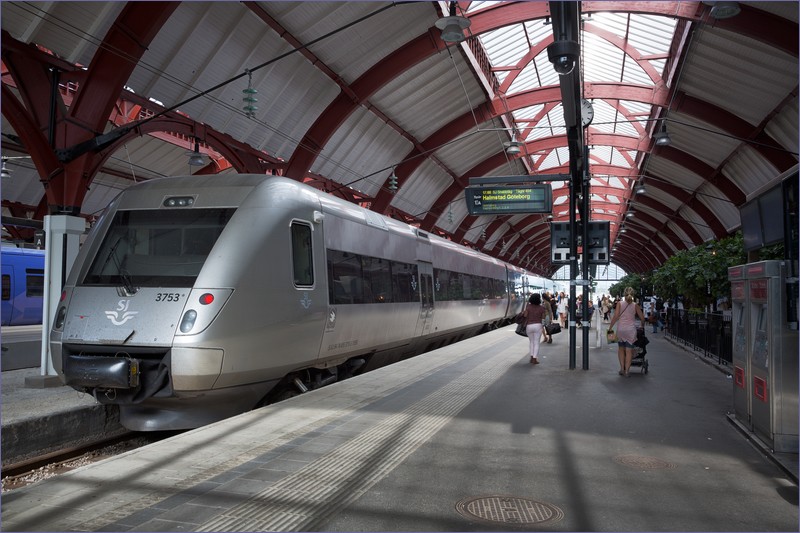
3. Train travel in Sweden – night trains
Night trains connect Sweden’s largest cities. I highly recommend the comfortable sleeping cars. Throughout the year, Swedish Railways runs domestic night trains on the following routes:
Gothenburg/Stockholm – Umeå/Luleå
Gothenburg/Stockholm – Duved
Stockholm – Malmö
Snälltåget operates a year-round night passenger train between Stockholm Malmö and a seasonal Stockholm – Åre train.
There are also international night trains Stockholm – Narvik and Stockholm – Berlin via Denmark.
The following carriages are available on Swedish Railways night trains:
seating carriage – almost all Swedish night trains have carriages with seats. These are second-class open coaches equipped with air conditioning and vacuum toilets.
couchette carriage (liggvagn) – an air-conditioned carriage with six-person bunks. On both sides of the carriage there are toilets and a small room with a washbasin. There are compartments for men, women and mixed compartments. The ticket includes a pillow, blanket and sheet. Groups of 4-6 people can reserve the entire compartment. . The middle bunks are folded down during the day to provide comfortable seating.
sleeping car (sovvagn) – Swedish sleeping cars are the most comfortable sleeping cars I have ever traveled in. Second class carriages with three-person compartments with a washbasin in the compartment are available. Toilets in this class are located on both sides of the carriage. First class carriages have 2-bed compartments and a toilet with a shower in the cabin. The price of a first-class ticket also includes breakfast in the bar car or a designated bar at the station.
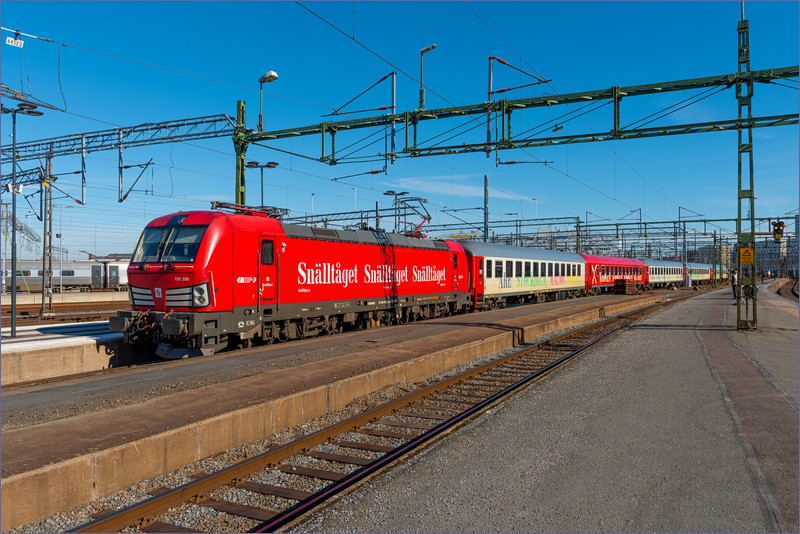
4. The best offers for visitors
One-way ticket prices for long-distance trains in Sweden, especially when purchased just before departure, are very high. The best option for train travel around the country is an Interrail pass. Almost all long-distance trains require mandatory seat reservations, so with the removal of ticket machines and station ticket offices, travelers with a paper Interrail pass may face difficulties reserving seats. This issue may be resolved in the future.
Travelers using local and regional trains in selected Swedish cities and regions can take advantage of affordable network tickets offered by regional transport operators or local governments.
The best offer for tourists is provided by Skånetrafiken, valid on regional trains and buses throughout Skåne and the Copenhagen area. Of special note is the 48-hour tourist ticket (Turistbiljett 48 timmar), available in two versions: one valid only in Skåne, and another also valid on the Danish side of the Öresund Strait. While not cheap, the ticket is also valid on public transport in Copenhagen, and on regional trains to Helsingør or Roskilde. For the 24-hour version, a zonal system applies.
www.skanetrafiken.se – official website
Storstockholms Lokaltrafik (SL) – the operator of Stockholm’s commuter rail network – offers network tickets for tourists. Available options include 24-hour, 72-hour, and weekly tickets. These can be purchased electronically via the “SL-Reseplanerare och biljetter” app (“SL Journey Planner and Tickets”) or loaded onto an SL Smart Card.
Stostockholms lokaltrafik (SL) – official website
In the Uppsala region, 24-hour and 72-hour tickets (UL Season Ticket) are available. These tickets are valid on city buses, regional buses, and Mälartåg regional trains on the Uppsala–Sala and Uppsala–Gävle routes. According to the local transport authority, the tickets are also valid on the Uppsala–Arlanda/Märsta route and on SJ shuttle trains between Uppsala–Knivsta–Arlanda, although this may need to be verified.
www.ul.se – official website
A similar offer is the 24-hour ticket valid in the Gävleborg region. It can be purchased either for the city of Gävle only or for the entire region. It’s valid for 24 hours on X-Trafik trains and buses, and there is also a combined version for both the X-Trafik and UL regions (Gävleborg and Uppsala provinces).
www.xtrafik.se – official website
Östgötatrafiken offers 24-hour tickets that allow travel on buses, trams, and trains operating under the regional transport authority. A zonal system is in place (you can purchase a ticket for the entire region). A cheaper off-peak ticket (Lågtrafikbiljetten) is also available. The ticket is valid on regional trains between Norrköping and Motala via Linköping and Mjölby, as well as Mjölby–Tranås, and on many bus routes.
www.ostgotatrafiken.se – official website
The Kalmar region also offers 24-hour tickets. The zonal division is complex, and the ticket for all zones is relatively expensive. However, the ticket allows you to use public transport on the island of Öland as well.
www.kalmarlanstrafik.se – official website
Västtrafik, the public transport authority for the Gothenburg area, offers 24-hour and 72-hour tickets valid on city buses, trams, regional trains, and ferries. A zonal system is in place, but ABC-zone tickets, valid in all zones, are available. The ticket is valid, for example, on trains between Gothenburg–Borås, Gothenburg–Falköping–Töreboda, and Gothenburg–Lidköping–Örebro.
www.vasttrafik.se – official website
Värmlandstrafik offers 24-hour and 72-hour tickets for city buses, regional buses, and regional trains operated by SJ and Tågab. The main cities in the region include Kristinehamn and Karlstad.
www.varmlandstrafik.se – official website
5. Narrow-gauge railways in Sweden
There are several narrow-gauge railways located in various regions. Swedish narrow-gauge railways usually run only in the summer season and usually only on weekends. Almost all of them are operated by volunteers.
Most popular narrow-gauge railways:
Anten-Gräfnäs Järnväg (AGJ) – steam hauled trains or railbuses from Anten to Gräfsnäs (12 km).
Lennakatten – narrow-gauge line from Uppsala to Faringe along sparsely populated forest areas. (33 km)
Ohsabanan – vintage trains running on disused Ohs Bruk – Bor Norra railway line (14.5 km).
Östra Södermanlands Järnväg – narrow-gauge railway located near Stockholm.
Narrow-gauge railways in Sweden – a full list (without miniature railways)
6. Heritage railways in Sweden
There are several operating heritage railways in Sweden. Some of them run trains on railway lines active in regular traffic, others on disused lines. Some railways run trains several times a year, several on holiday weekends and selected days. Ticket prices for vintage trains and historic railbuses are usually much more expensive than for regular trains. Interrail tickets and other network passes are not accepted.
Most popular heritage railways:
Dal-Västra Värmlands Järnväg – rides on historic railbuses on the scenic Bengtsfors – Mellerud route in the Värmland region (46 km)
Skånska Järnvägar – steam hauled vintage trains trains from Brösarp to Sankt Olof (13.4 km) on a disused railway line.
Heritage railways in Sweden – a full list
7. Train travel in Sweden – Inlandsbanan
Inlandsbanan is the name of a railway line running from Kristinehamn to Gällivare through sparsely populated regions of Sweden. The length of the line is almost 1300 kilometers (1288-1926 according to various sources).
The line was constructed in sections between 1908 and 1937. In 1937, the builders of the last section, Jokkmokk – Sorsele, met in Kåbdalis. The railway was officially opened on August 6, 1937.
Initially, trains consisting of a steam locomotive and carriages ran on the route, which were later replaced by railcars.
For many years, the line was managed by Swedish Railways. In the early 1990s, Swedish Railways decided to close the line due to unprofitability. In 1992, the local authorities of several regions formed the company Inlandsbanan AB, which took over the operation of the line.
Currently, Inlandsbanan is one of Sweden’s most well-known tourist attractions. Services run on three routes: Kristinehamn – Mora, Mora – Östersund, and Östersund – Gällivare. A full day is needed to travel each route; for example, the journey from Östersund to Gällivare (746 km) takes almost 14 hours, including an almost hour-long stop for lunch.
The line is not electrified. Journeys are conducted using vintage diesel multiple units Y1, which were also previously used on local lines in Serbia, Croatia, and Kosovo. These vehicles also operate on the routes in Uruguay.
A network ticket valid for 14 days is available for the line. In the summer, tourist trains are also operated for travel agency clients, including a program of sightseeing, accommodation, transportation, and lodging. Among the tourist trains in operation are classic compositions consisting of a steam locomotive or diesel engine and carriages.
Indlandsbanan – official website
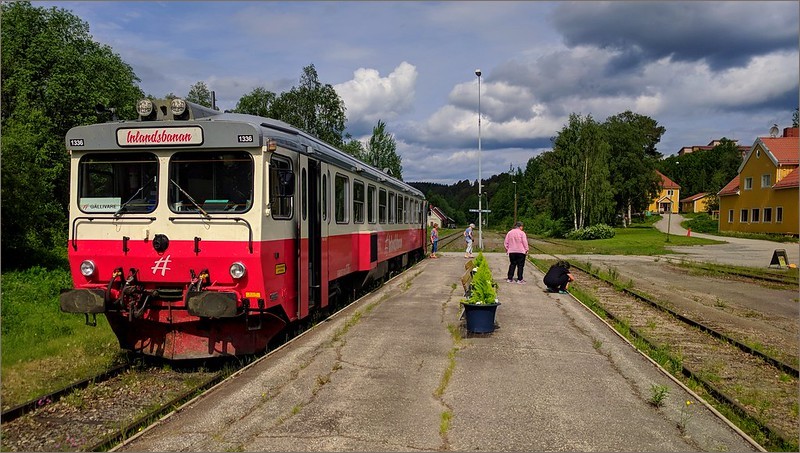
8. Railways on Swedish islands
Currently, there are no regular passenger services on the islands of Gotland and Öland. In the past, passenger trains operated on both islands.
On the island of Gotland there are two narrow-gauge railways:
Bläse Kalksbruk – a narrow-gauge railway located seven kilometers away from the nearest public transport stop. The railway once connected the port of Bläse with the quarry, and now is used for tourist purposes. Trains run only in summer season, carrying tourists from the museum up to the old quarry, and back again. The total length of the route is 2,2 km and the return trip takes about 40 minutes.
Gotlands Hesselby Jernväg is a forest narrow-gauge railway which runs seasonally between Hesselby and Eken. On days when trains do not run, visitors can hire a pedal driven trolleys.
On the island of Öland there is an only one operational railway.
Böda Skogsjärnväg is a forest railway (600 mm gauge) on the island of Öland. Trains run on summer holiday weekends from the last weekend of June to the last weekend of August. The trains carry passengers along four-kilometer route from Fagerrör to Trollskogen. The round trip takes 75 minutes. Diesel and steam hauled.
9. Funicular railways in Sweden
Two funicular railways are currently operational in Sweden:
Åre Bergbana – a funicular railway in the town of Åre, popular among skiing and mountain hiking enthusiasts. It connects the town’s main square with the Fjällgården station located on a hill near the hotel of the same name. The 790-meter-long line was built between 1908 and 1910. The railway is powered by an electric motor located at the upper station. It consists of two carriages that depart from the lower and upper stations simultaneously. They pass each other at the Fjällängen station. In the 1950s, there were plans to extend the line to the peak of Mörvikshummeln, but the project was not realized due to financial reasons.
Skansens Bergbana – a funicular railway built on the island of Djurgården in Stockholm. The railway was opened in 1897. In the 1940s, it operated only during the summer season, and it was closed in 1959. In the early 1970s, reconstruction began, and it resumed operation in 1973. The track gauge is 1000 mm, the line length is 196.4 meters, and the maximum speed is 2.5 m/s. The travel time between the starting and ending stations is 90 seconds.
10. Swedish Railway Museum
In mid-2024, the renovated Swedish Railway Museum in Gävle was reopened with completely new exhibitions, a new shop and a restaurant with a new patio.
The museum showcases the development of Swedish railways from the mid-19th century to the present day. Visitors can see a wide variety of exhibits – photos, documents, books, railway uniforms – but the most interesting is the rolling stock exhibition featuring over 300 vehicles: steam, diesel, and electric locomotives, railcars, and even one of the X 2000 trains that was once sold to China and returned after the railway line it operated on was upgraded. The collection includes Prince August, the oldest operable steam locomotive in the world.
There is a new playroom and a new out outdoor playground for the little ones. Visitors can visit also vehicle storage facility, the Train Hall (Tåghallen). During the peak season, railbuses operate between the museum and the Train Hall. Travel on the railbus is included in the entrance fee.
Swedish Railway Museum – official website
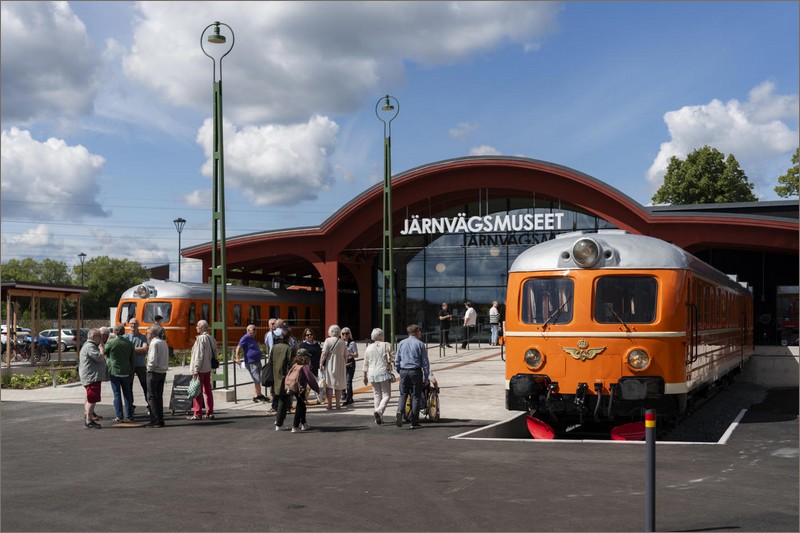
11. Train travel in Sweden – international trains
There are international trains from Sweden to Norway, Denmark and Germany. Passenger trains are operated by various companies.
Norway
Sweden has a railway connections with Norway. Offer for passengers has improved in recent years. There are long-distance trains from Oslo to Gothenburg and from Oslo to Stockholm, overnight train from Stockholm to Narvik and regional trains from Trondheim to Storlien.
Timetable, tickets and prices:
vy.no – – tickets for trains Oslo – Gothenburg and Trondheim – Storlien
sj.se – tickets for trains Oslo – Stockholm and Stockholm – Narfik
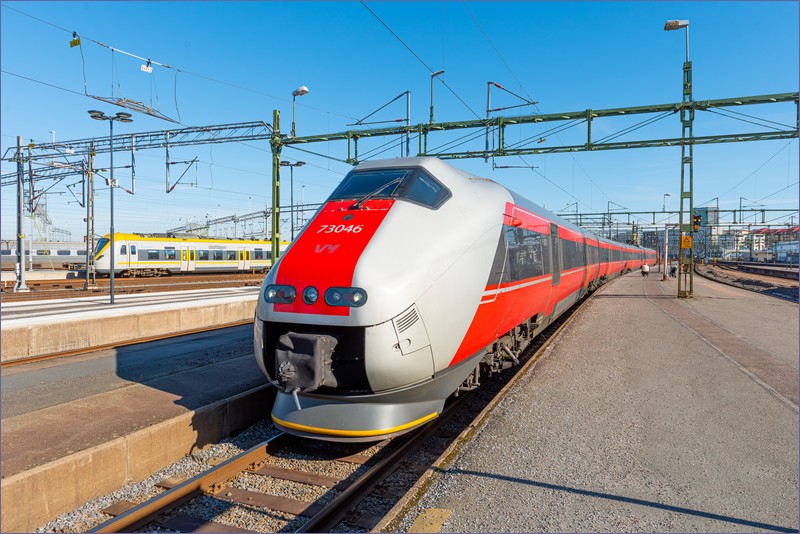
Denmark and Germany
Øresundståg/Öresundståg trains run between Copenhagen and Malmö every 20 minutes (from morning to evening). Trains most often start in Helsingør and end not only in Malmö, some of them even go on to Gothenburg. The most beautiful part of the route is the crossing over the Oresund Bridge over the Baltic Sea. Trains also stop at Copenhagen-Lufthaven station.
Oresundstag – official website, more information
There are also direct X2000 trains Copenhagen – Stockholm, but timetables and prices should be checked on the Swedish Railways website:
sj.se – timetable and prices of X2000 trains.
Night trains from Stockholm to Berlin also pass through Denmark. Trains are operated by two carriers – Swedish Railways (all year round train) and Snalltaget (seasonal train).
Swedish Railways – official website
Snalltaget – official website
Finland
There are no international train to Sweden. Information about international trains from Sweden to Finland going to start in a short period of time has been appearing in the media for many years. But the trains didn’t run.
Related articles:
Narrow gauge railways in Sweden
Heritage railways in Sweden
Railways in Europe by country
